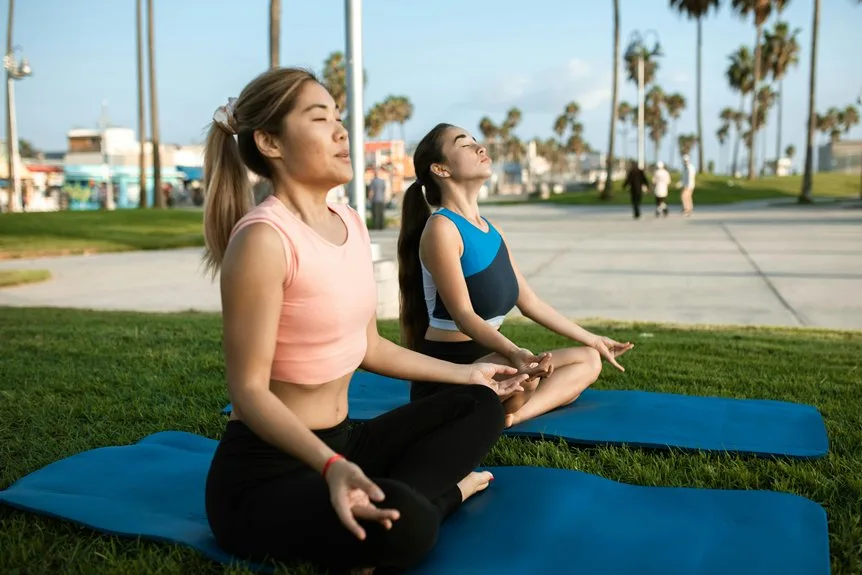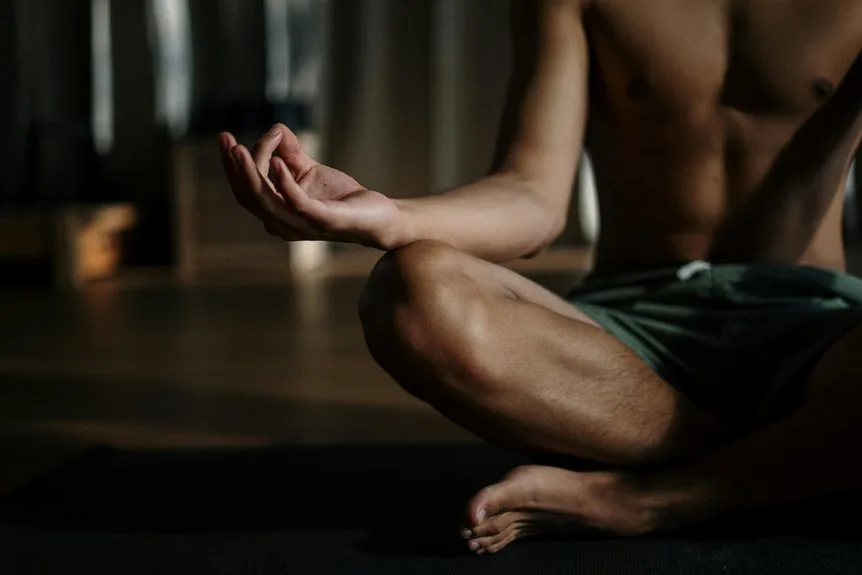Many people rush through their days on autopilot, barely noticing the small moments that make life unique. Adding mindfulness can shift this routine, helping a person feel more present and less stressed. It’s not about sitting cross-legged for hours; instead, it’s about weaving simple, mindful actions into ordinary routines. With a few easy tweaks—like mindful breathing or savoring a meal—anyone can start to notice subtle but meaningful changes. Curious how these small shifts actually work?
What Is Mindfulness and Why Does It Matter?
Ever wondered what it really means to be “mindful”? Mindfulness is simply paying close, non-judgmental attention to the present moment, tuning into sights, sounds, and sensations with genuine curiosity.
By noticing thoughts and feelings without trying to change them, people create a sense of awareness that’s accepting, not critical. Science shows that this kind of awareness can lead to better mental health and effective stress reduction.
Practicing mindfulness helps quiet autopilot habits, cultivates a calm mind, and encourages deeper connection with both self and community. Over time, it enhances focus and resilience, helping everyone feel a little more grounded. For those seeking a personalized wellbeing journey, places like Sensei Porcupine Creek offer tailored experiences guided by trained professionals.
Mindful Wakeup: Start Your Morning With Intention
A mindful wakeup can convert the ordinary act of getting out of bed into something meaningful. Before reaching for a phone or checking emails, one might sit comfortably, close their eyes, and tune in to bodily sensations. Taking a moment to breathe deeply—three nourishing breaths—helps anchor the mind in the present moment. Setting a morning intention, such as aiming for kindness or connection, aligns both subconscious and conscious goals. This brief routine encourages reflection on how to show up with compassion. Over time, a mindful wakeup can improve focus, reduce stress, and nurture a sense of belonging throughout the day. For those seeking a deeper experience in mindfulness and wellness, visiting a contemporary wellness destination like Two Bunch Palms, with its emphasis on balance and healing, can further enhance one’s journey.
Mindful Eating: Savor Every Bite
Mindful eating starts with engaging all the senses—notice the colors on your plate, inhale the aroma, and feel the texture of each bite. By slowing down at mealtimes, a person can truly appreciate the flavors and recognize when their body is satisfied, instead of rushing through a meal on autopilot. This simple shift not only adds enjoyment but also helps with better digestion and a stronger connection to real hunger cues. At places like The Ravens restaurant, known for outstanding vegetarian cuisine, one can experience the full benefit of mindful eating amid a serene natural setting.
Engaging Your Senses
Taking a moment to truly engage the senses can convert eating from a routine task into an experience worth savoring. By practicing sensory awareness, anyone can bring full attention to each meal. Before picking up a fork, pause and take 8-10 deep breaths, setting a calm tone. Notice the physical sensations of hunger and rate them, tuning in to the body’s genuine needs. As eating begins, focus on the senses—flavors, textures, and aromas—without rushing. Choosing foods based on mindful eating rather than habit nurtures belonging within one’s own body, making meals a shared moment with oneself. For those seeking a holistic experience, consider exploring holistic spa rituals offered at luxurious resorts like Four Seasons Resort and Residences Napa Valley.
Slowing Down Mealtimes
Often, meals can feel like a race against the clock, with bites disappearing before anyone even registers the taste. Mindful eating invites people to slow down and really notice their bodily sensations, from the first aroma to the last bite.
By pausing for 8-10 deep breaths before eating, individuals can increase their awareness of true hunger cues. Slowing down lets flavors shine and increases satisfaction, while also supporting better digestion and reducing discomfort.
Rating hunger on a scale from one to ten helps guide mindful choices. Over time, these habits can nurture self-control and create a sense of connection at the table.
Mindful Pause: Shift Out of Autopilot
There’s a certain magic that happens when someone interrupts the steady flow of their daily routine with a conscious pause. By embracing a mindful pause, people can break the grip of automatic neural pathways, inviting conscious awareness to the foreground.
Even a small, deliberate pause—like taking a deep breath—can spark neuroplasticity, gently reshaping old habits into new, thoughtful responses. These simple moments connect individuals, creating a shared sense of intentionality in daily life.
For those wanting to shift out of autopilot, try these ideas:
- Place sticky notes as gentle reminder cues
- Pause before answering your phone
- Savor a few deep breaths before meetings
Mindful Workout: Move With Awareness
While many people see working out as a race to the finish or just another task on the to-do list, mindful movement invites a whole new approach. By setting a clear intention—like connecting with your body or reducing stress—physical activity becomes more meaningful.
Breathing in sync with every motion builds body awareness and keeps attention anchored in the present moment. Whether it’s walking, dancing, or even gardening, noticing how muscles, joints, and skin feel can metamorphose exercise into a grounding experience.
These mindful movements, practiced regularly, nurture a sense of calm and belonging, making workouts a welcome pause in the day.
Mindful Driving: Turn Commutes Into Calm
Long commutes can turn anyone’s mood sour, but a few mindful habits can make all the difference behind the wheel.
By focusing on slow, steady breaths and showing a little compassion for the drivers around them, anyone can trade road rage for a calmer ride.
Even the most frustrating traffic jam can become a chance to pause, notice the world outside, and reflect rather than react.
Breathe Through Traffic Stress
A daily commute can easily turn into a stress-filled voyage, especially when traffic seems to crawl and tempers begin to rise. By practicing mindful breathing, anyone can reshape these tense moments into opportunities for stress reduction and relaxation.
Focusing on the sensation of breath, rather than the frustration outside, gives the mind a gentle anchor. This simple act helps with emotional regulation and keeps reactions calm.
Here are a few ways to bring mindfulness into your drive:
- Focus on breath: Inhale for four seconds, exhale for four seconds.
- Notice how your body feels with each breath.
- Check in with your emotions regularly.
Compassion for Other Drivers
Taking a few deep breaths in traffic is just the beginning of mindful driving—there’s also power in the way drivers relate to others on the road. Practicing empathy and patience changes daily commutes into opportunities for genuine connection, even among strangers.
Drivers who recognize that others might be having a tough day naturally experience stress reduction themselves. With increased awareness, it becomes easier to step back and avoid reactive behaviors like honking or shouting.
Instead, brief pauses to check in with emotions and focus on the present moment help cultivate a sense of community, making every voyage feel a bit lighter.
Transform Frustration Into Reflection
Traffic jams have a way of pushing everyone’s buttons, yet there’s a surprising alternative to stewing in frustration behind the wheel. Mindful driving turns commutes into moments of awareness and reflection.
Instead of reacting impulsively, one can use deep breathing to calm nerves and regulate emotions. Recognizing traffic as an unavoidable part of life helps reframe frustration, making space for patience.
Bringing gentle attention to sounds, sensations, or even the scenery creates room for mindfulness. These small shifts encourage a sense of belonging, even in crowded lanes:
- Take slow, deep breaths
- Notice your surroundings without judgment
- Offer silent compassion to other drivers
Observing Your Thoughts Without Judgment
Noticing thoughts as they pop up, without immediately judging or wrestling with them, is a surprisingly simple way to practice mindfulness. By just observing thoughts as they come and go, awareness is gently strengthened.
Instead of labeling a thought as good or bad, one can simply note it—maybe with a soft “thinking” or “just a thought.” This observation builds distance from old habits, allowing judgment to fade.
Over time, this mindful awareness can ease stress and elevate emotional clarity. It’s a shared human experience—everyone has thoughts, but learning to watch them with kindness makes room for true acceptance.
Staying Present During Everyday Tasks
How often does a simple daily chore slip by on autopilot, barely noticed? By bringing mindfulness into routine activities, anyone can turn ordinary moments into opportunities for belonging and connection.
Slowing down and focusing on the present, whether it’s washing dishes or folding laundry, builds attention and awareness. Sensory details, like the warmth of water or the sound of fabric, can anchor awareness in the now.
Try these ideas:
- Notice textures, smells, and sounds during routine tasks
- Place a gentle reminder, like a sticky note, to prompt mindful attention
- Focus on one activity at a time, avoiding multitasking
Mindful Breathing for Stress Relief
A simple way to hit the pause button during a stressful day is through mindful breathing. This practice invites people to focus on the feeling of air moving in and out of their lungs, encouraging deep breaths that trigger the body’s relaxation response.
By slowly inhaling and exhaling, such as with the 4-7-8 method, stress relief becomes more than just a hope—it’s science in action. Regular mindful breathing can lower stress hormones, improve heart rate variability, and enhance emotional regulation.
Even a few minutes spent together in mindful breathing can help a group feel calmer, steadier, and mentally clearer.
Creating Mindfulness Triggers in Your Environment
Small visual cues, like a sticky note on the fridge or a yoga mat in the living room, can nudge anyone toward mindful moments during a busy day. Placing these signals where they’ll be seen most—by the door, next to a computer, or even on a bathroom mirror—makes it much harder to forget about staying present.
Visual Reminders for Awareness
Ever notice how certain objects around the house can instantly grab attention—like a bright sticky note stuck to the fridge or a quirky coffee mug on the desk? These everyday items make perfect mindfulness triggers, serving as visual cues to nudge awareness in the middle of busy routines.
By designing an environment filled with helpful prompts, individuals can train their brains—thanks to neuroplasticity—to pause and breathe more often. Keep things fresh by updating or moving these cues regularly.
Try these ideas:
- Place inspiring images where you’ll see them often
- Use “if-then” reminders with favorite objects
- Swap out notes to spark curiosity
Strategic Placement of Cues
One of the easiest ways to weave mindfulness into daily life is by placing cues exactly where they’re needed most. Visual cues like a yoga mat in the hallway or sticky notes on the mirror act as friendly triggers, gently nudging mindful habits throughout the day. Updating these prompts—maybe with a funny doodle or a new phrase—keeps them fresh and engaging.
Using “if-then” cues, such as “If I check my phone, then take a breath,” helps turn mindful moments into automatic responses. By shaping the environment with these intentional triggers, anyone can make mindfulness feel natural and shared within everyday routines.
Building Mindfulness Habits With Small Shifts
Mindfulness doesn’t have to be an all-or-nothing pursuit; instead, it can quietly slip into daily life through a series of manageable, almost invisible shifts. Building mindfulness habits is often about sprinkling small shifts throughout a daily routine, using clever triggers and consistent actions to reinforce awareness.
Sticky notes on mirrors, phone backgrounds, or playful “If this, then that” prompts help nudge attention back to the present. When these cues become too familiar, invigorating them keeps things interesting and effective.
- Place visual reminders where you’ll see them often
- Rewrite triggers with a touch of humor
- Celebrate small wins, like a mindful breath
Tracking Your Progress and Noticing Change
For anyone weaving mindfulness into daily life, tracking progress and noticing change can feel a bit like watching a garden grow—subtle at first, but surprisingly rewarding over time. By jotting down quick reflections or using simple logs, people start to notice the little shifts: a calmer reaction here, a clearer mind there.
Tracking these moments enhances awareness and gives a sense of accomplishment. Regular reflection highlights areas of growth and helps spot patterns in mood or stress. Over weeks or months, these small notes reveal real progress, supporting well-being and reminding everyone that their mindfulness expedition is truly taking root.
Resources and Support for Your Mindfulness Journey
Noticing those small but steady changes is encouraging, but sometimes a little extra support can make the expedition smoother and even more enjoyable. There’s a whole world of resources ready to enhance anyone’s mindfulness practice, whether through emotional support or practical guidance.
Guided meditation apps like Calm or Headspace offer easy access to meditation moments, while books and online courses bring scientific research and real-life tips right to the reader’s fingertips.
To help everyone feel connected and cared for, consider these:
- Guided meditation apps for daily routines
- Emotional support tools, like self-reflection journals
- Evidence-based resources, including books and online courses
Frequently Asked Questions
How to Add Mindfulness to Your Day?
To add mindfulness to daily life, one might practice mindful breathing, gratitude journaling, body scan exercises, mindful walking, and sensory awareness. These approaches can nurture a sense of connection, presence, and belonging within a supportive community or environment.
What Are the 5 R’s of Mindfulness?
Echoing ancient practices, the 5 R’s of mindfulness—Recognize, Reframe, Release, Respond, and Reset—invite breath awareness, body scan, sensory observation, present moment focus, and mindful listening, nurture a shared voyage toward deeper connection and belonging.
How Do I Start My Day With Mindfulness?
The current question invites exploration of how individuals can begin their day with practices like morning meditation, mindful breathing, gratitude journaling, mindful stretching, or an intentional breakfast, nurturing connection, presence, and a sense of belonging from the very start.
What Are the 3 C’s of Mindfulness?
Like a compass guiding a traveler, the 3 C’s of mindfulness—Curiosity, Compassion, and Calmness—anchor present moment awareness. They enhance mindful breathing exercises, sensory observation techniques, emotional regulation strategies, and mindful listening practices, promoting deeper connection and belonging.
Final Thoughts
Bringing mindfulness into everyday life doesn’t require hours of meditation or fancy equipment—it’s about small, thoughtful moments sprinkled throughout the day. Imagine how different things could feel if everyone took a mindful breath before reacting or simply savored a bite of lunch. Isn’t it worth pausing to notice the world a little more? Over time, these tiny shifts add up, making stress lighter and joy easier to find, right in the middle of daily routines.







